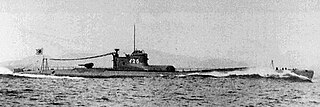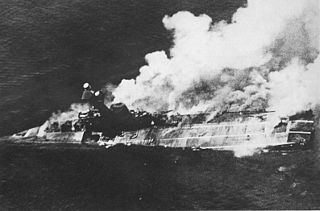
USS Wahoo (SS-238) was a Gato-class submarine, the first United States Navy ship to be named for the wahoo. Construction started before the U.S. entered World War II, and she was commissioned after entry. Wahoo was assigned to the Pacific theatre. She gained fame as an aggressive and highly successful submarine after Lieutenant Commander Dudley Walker "Mush" Morton became her skipper. She was sunk by Japanese aircraft in October 1943 while returning home from a patrol in the Sea of Japan.

USS Scamp (SS-277), a Gato-class submarine, was the first ship of the United States Navy to be named for the scamp grouper, a member of the family Serranidae.

I-25 (イ-25) was a B1 type (I-15-class) submarine of the Imperial Japanese Navy that served in World War II, took part in the Attack on Pearl Harbor, and was the only Axis submarine to carry out aerial bombing on the continental United States in World War II, during the so-called Lookout Air Raids, and the shelling of Fort Stevens, both attacks occurring in the state of Oregon.

The first USS Batfish (SS/AGSS-310) is a Balao-class submarine, known primarily for the remarkable feat of sinking three Imperial Japanese Navy submarines in a 76-hour period, in February 1945. USS Batfish is the first vessel of the United States Navy to be named for the batfish, a fish found off the coast of Peru, at depths ranging from 3 to 76 meters.

The first USS Parche (SS-384/AGSS-384) was a United States Navy submarine. She bore the name of a butterfly fish, Chaetodon capistratus. Parche was a Balao-class submarine that operated in World War II.

There was considerable Axis naval activity in Australian waters during the Second World War, despite Australia being remote from the main battlefronts. German and Japanese warships and submarines entered Australian waters between 1940 and 1945 and attacked ships, ports and other targets. Among the best-known attacks are the sinking of HMAS Sydney by a German raider in November 1941, the bombing of Darwin by Japanese naval aircraft in February 1942, and the Japanese midget submarine attack on Sydney Harbour in May 1942. About 40 Allied merchant ships were damaged or sunk off the Australian coast by surface raiders, submarines and mines. Japanese submarines also shelled three Australian ports and submarine-based aircraft flew over several Australian capital cities.

I-26 was an Imperial Japanese Navy B1 type submarine commissioned in 1941. She saw service in the Pacific War theatre of World War II, patrolling off the West Coast of Canada and the United States, the east coast of Australia, and Fiji and in the Indian Ocean and taking part in Operation K, preparatory operations for the Aleutian Islands campaign, and the Guadalcanal campaign, the Marianas campaign, and the Battle of Leyte Gulf. She was the first Japanese submarine to sink an American merchant ship in the war, damaged the aircraft carrier USS Saratoga (CV-3), sank the light cruiser USS Juneau (CLAA-52), and was the third-highest-scoring Japanese submarine of World War II in terms of shipping tonnage sunk. Her bombardment of Vancouver Island in 1942 was the first foreign attack on Canadian soil since 1870. In 1944, I-26′s crew committed war crimes in attacking the survivors of a ship she sank. She was sunk in October 1944 during her ninth war patrol.

German submarine U-201 was a Type VIIC U-boat of the Kriegsmarine in World War II.

The Battle of the Caribbean refers to a naval campaign waged during World War II that was part of the Battle of the Atlantic, from 1941 to 1945. German U-boats and Italian submarines attempted to disrupt the Allied supply of oil and other material. They sank shipping in the Caribbean Sea and the Gulf of Mexico and attacked coastal targets in the Antilles. Improved Allied anti-submarine warfare eventually drove the Axis submarines out of the Caribbean region.
The Bird-class minesweeper was a class of naval trawlers built for the Royal New Zealand Navy and which served during the Second World War. A total of three vessels in the class were built: Kiwi, Moa and Tui. All were named for New Zealand native birds and were also referred to as corvettes.
HMNZS Tui (T234) was a Bird-class minesweeper of the Royal New Zealand Navy. She was commissioned in 1941 for minesweeping and anti-submarine roles. Tui was the first of two ships with this name to serve in the Royal New Zealand Navy and was named after a native bird from New Zealand.

Prior to World War II, the Indian Ocean was an important maritime trade route between European nations and their colonial territories in East Africa, the Arabian Peninsula, British India, Indochina, the East Indies (Indonesia), and Australia for a long time. Naval presence was dominated by the Royal Navy Eastern Fleet and the Royal Australian Navy as World War II began, with a major portion of the Royal Netherlands Navy operating in the Dutch East Indies and the Red Sea Flotilla of the Italian Regia Marina operating from Massawa.

I-10 was an Imperial Japanese Navy Type A1 submarine that served during World War II. Designed as a submarine aircraft carrier, she was commissioned in 1941 and supported the attack on Pearl Harbor, operated in the Indian Ocean — including support for the 1942 midget submarine attack on Diego Suarez — and in the New Caledonia and New Zealand areas, and took part in the Guadalcanal campaign and Marianas campaign before she was sunk in 1944 during her seventh war patrol.
I-11 was an Imperial Japanese Navy Type A1 submarine that served during World War II. Designed as a submarine aircraft carrier and submarine squadron flagship, she was commissioned in 1942. She participated in the Guadalcanal campaign and patrolled off Australia, New Caledonia, and the Ellice Islands before she disappeared in 1944 during her sixth war patrol. She badly damaged the Royal Australian Navy light cruiser HMAS Hobart in 1943.
Ro-110 was an Imperial Japanese Navy Ro-100-class submarine. Completed and commissioned in July 1943, she served in World War II, operating in the Indian Ocean. She was sunk in February 1944 during her third war patrol.

Aikoku Maru (愛国丸) was an armed merchant cruiser of the Imperial Japanese Navy in World War II. The ship entered service in 1940, the ship was later converted to an ammunition ship. She was sunk in February 1944 during Operation Hailstone.

Commander Gordon Bridson, was a New Zealand swimmer who won two silver medals at the 1930 British Empire Games. He was also in the New Zealand Royal Naval Volunteer Reserve and in the Second World War, he served in the Royal New Zealand Navy. Seconded to the Royal Navy in 1940, he commanded a minesweeper vessel that accompanied coastal convoys along the English Channel. He was later the commander of the minesweeper HMNZS Kiwi which, with her sister ship Moa, sunk the Japanese submarine I-1 off Guadalcanal in the Solomon Islands.
I-37, originally numbered I-49, was a Japanese Type B1 submarine in service with the Imperial Japanese Navy during World War II. Commissioned in 1943, she made three war patrols, all in the Indian Ocean, during the last of which her crew committed war crimes by massacring the survivors of the merchant ships she sank. Subsequently, converted into a kaiten manned suicide attack torpedo carrier, she was sunk during her first kaiten mission in 1944.
I-69, later I-169, was an Imperial Japanese Navy Kaidai-class cruiser submarine of the KD6 sub-class commissioned in 1935. She served in World War II, during which she conducted six war patrols and took part in operations supporting the attack on Pearl Harbor, the Battle of Midway, the Guadalcanal campaign, the Aleutians campaign, and the defense of the Gilbert Islands. She sank in a diving accident in April 1944.

I-6 was an Imperial Japanese Navy J2 type submarine commissioned in 1935. She was a large cruiser submarine that served in the Second Sino-Japanese War and World War II. During the latter conflict she operated in support of the attack on Pearl Harbor, torpedoed the aircraft carrier USS Saratoga (CV-3), conducted anti-shipping patrols in the Indian Ocean and South Pacific Ocean, and took part in the Aleutian Islands campaign and New Guinea campaign before she was sunk in June 1944.













